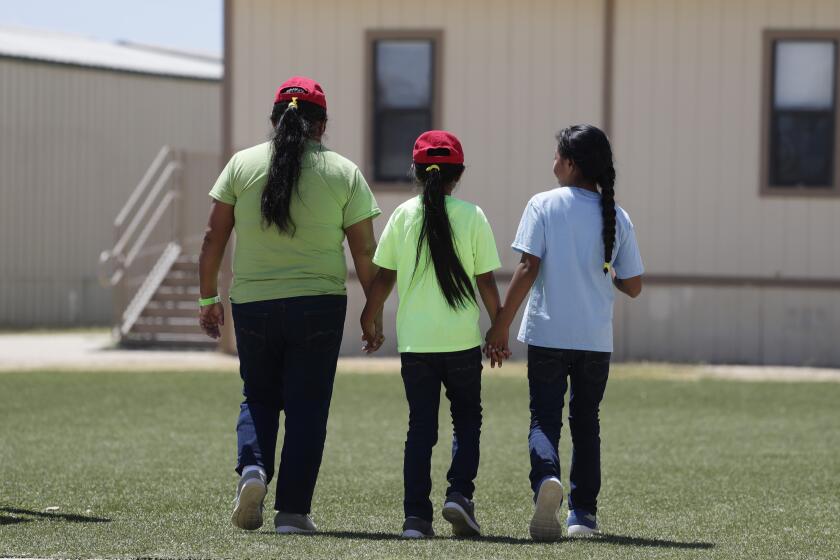How does a water district ‘go green’?
- Share via
 Frontier Project Foundation building
Frontier Project Foundation building
Californians may be some of the most experienced U.S. residents when it comes to water conservation. While recent events have put water conservation in the spotlight, how do we get local water users to not only care about water, but to also take action? That’s the big question California’s Cucamonga Valley Water District is working to answer. They don’t just provide water to 200,000 Californians in and around Rancho Cucamonga — they’re also teaching the community how to practice responsible stewardship of natural resources.
To this end, the Frontier Project Foundation, a nonprofit founded by CVWD, fosters community awareness through public tours, community forums, school field trips and educational workshops. Arrowhead® Brand 100% Mountain Spring Water helps support CVWD because of their shared commitment to water stewardship and community education.
The community commitment is ever-present at the CVWD’s Rancho Cucamonga campus: “There’s typically some type of workshop or class going on, many of which are open to the general public,” said CVWD communications and outreach manager Kristeen Farlow. The workshops range from programs showing residents how to save water in their landscaping all the way to training that helps teachers show their students how to make informed energy decisions.
The CVWD’s Environmental Learning Center, on the Rancho Cucamonga campus, was developed to offer students in first through sixth grades hands-on water and environmental education field trip opportunities. Since 2009, over 16,000 students have enjoyed the Environmental Learning Center and Learning Garden.
“Our thinking with the Learning Center was that we would bring science out of the textbook and into the hands of students,” Farlow said. “They’re able to do things like dissect an owl pellet, tap-water testing [and] look through microscopes and identify microorganisms.”
As the Frontier Project Foundation’s lead education sponsor, the Arrowhead brand also helps support CVWD’s High School Solar Cup boat-building competition and Poster Contest. The Solar Cup competition is a seven-month-long program in which students from all over Southern California build and race solar-powered boats, learning about both engineering and conservation in the process. Another program, the Fifth Grade Poster Contest, offers students a chance to create artwork on a conservation-themed topic and compete for the top prize. Each of these education programs targets a different audience, helping CVWD reach their diverse community and beyond.
On the same campus, the Frontier Project Foundation constructed the Frontier Project sustainable demonstration building.
“The purpose of the building is to provide the community with a resource to learn how to implement environmentally efficient products, systems and practices,” Farlow explained.
The architecturally stunning 14,200-square-foot Frontier Project building reduces water consumption by 50 percent and energy usage by 30 percent, earning it a LEED Platinum certification. As well as incorporating water-efficient (and water-free) bathroom fixtures, the design of both the building itself and the surrounding landscaping prioritizes groundwater replenishment.

CVWD general manager Martin Zvirbulis
“This includes a rain-catchment system [and] a bioswale,” Farlow said. “We also have pervious paving and decomposed granite pathways. All of these elements work together to help us retain water onsite, replenish to the [groundwater] basin, and also use it onsite for landscape irrigation.”
As another way to both practice and teach water stewardship, CVWD has replaced its campus’s grass with low-water plants — native species and other low-water-use plant materials. The campus’s water-wise landscaping and the Frontier Project building’s demonstration garden are open for public visits Monday through Friday year-round. Visitors seeking landscape examples to implement at their home or business can also sign up for the CVWD Water Savvy Landscape Tour.
In the wider community, CVWD has spearheaded a cleanup program in Cucamonga Canyon — another way of both practicing and teaching stewardship. An area of great natural beauty famed for its pristine waterfalls, the Canyon is a source of high-quality water for the district. However, fire, trash and graffiti concerns linked to increasing visitor numbers resulted in the U.S. Forest Service closing the area to the public in 2013.
In partnership with the Arrowhead brand, the city of Rancho Cucamonga and the nonprofit Cucamonga Foothills Preservation Alliance, CVWD is working to restore and protect this valuable natural resource, with a plan to reopen the area to hikers and develop a long-term management sustainability plan.
“What that looks like is groups picking up trash, helping to redevelop some of the trailheads ... so [visitors] don’t have to walk through the source where our water is coming from,” Farlow said. Cleanup tactics have included a “graffiti blaster” tool to restore the natural appearance of Cucamonga Canyon’s dramatic rock faces.
“What Arrowhead has helped us to do over time is help supplement funding in areas related to our outreach, communication and education programs that may not have been achievable at the pace we were able to achieve them, historically,” CVWD general manager Martin Zvirbulis said. “Their sponsorship helps make these programs possible.”
—Paul Rogers for Arrowhead® Brand 100% Mountain Spring Water
Join CVWD for their flagship event, the annual Earth Day Celebration and CVWD open house, on Saturday, April 8, from 10 a.m. to 2 p.m., where nearly 2,000 visitors will converge on the CVWD campus to learn about all things environmental. Find more information here.
More to Read
Sign up for Essential California
The most important California stories and recommendations in your inbox every morning.
You may occasionally receive promotional content from the Los Angeles Times.










